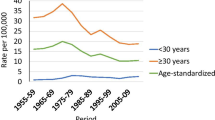Abstract
This study assesses cervical cancer disparities between Blacks and Whites in terms of stage at diagnosis in a Mountain West state. A total of 1,408 women diagnosed with cervical cancer between 1995 and 2010 were identified from the Nevada Central Cancer Registry. Logistic regression modeling examined the effect of race on stage at diagnosis in both Nevada and the Surveillance, Epidemiology and End Results (SEER) population. After controlling for the main confounders, no significant differences in stage at diagnosis were observed between Black and White females in Nevada (aOR 0.91; 95 % CI 0.57–1.43). In contrast, Black women in SEER areas had a 21 % higher odds of being diagnosed at an advanced stage compared to Whites. Our findings suggest a favorable disparity balance for cervical cancer in Nevada where Blacks are largely recent arrivals in relation to the remaining US, where Blacks have long been established.
Similar content being viewed by others
References
Siegel R, Naishadham D, Jemal A. Cancer statistics, 2013. CA Cancer J Clin. 2013;63(1):11–30.
Ward E, Jemal A, Cokkinides V, et al. Cancer disparities by race/ethnicity and socioeconomic status. CA Cancer J Clin. 2004;54(2):78–93.
Singh GK, Miller BA, Hankey BF, Edwards BK. Persistent area socioeconomic disparities in US incidence of cervical cancer, mortality, stage, and survival, 1975–2000. Cancer. 2004;101(5):1051–7.
Rep, MMWR Morb Mortal Wkly. Health disparities experienced by Black or African Americans—United States. Health. 2005;54(1):1–3.
Harris AL. The economic and educational state of Black Americans in the 21st century: should we be optimistic or concerned? Rev Black Polit Econ. 2010;37(3–4):241–52.
Aud S, Fox MA, KewalRamani A. Status and trends in the education of racial and ethnic groups. 2010. “Status and Trends in the Education of Racial and Ethnic Groups. NCES 2010-015.” National Center for Education Statistics.
US Department of Health and Human Services. Overview of the uninsured in the united states: a summary of the 2011 current population survey. http://aspe.hhs.gov/health/reports/2011/cpshealthins2011/ib.shtml. Updated 2011. Accessed 24 Sep 2013.
Wolff M, Bates T, Beck B, Young S, Ahmed SM, Maurana C. Cancer prevention in underserved African American communities: barriers and effective strategies—a review of the literature. WMJ-MADISON. 2003;102(5):36–40.
Egede LE. Race, ethnicity, culture, and disparities in health care. J Gen Intern Med. 2006;21(6):667–9.
US Census Bureau. The black population: 2010. http://www.census.gov/prod/cen2010/briefs/c2010br-06.pdf. Updated 2011. Accessed 20 Sep 2013.
Patel DA, Barnholtz-Sloan JS, Patel MK, Malone J Jr, Chuba PJ, Schwartz K. A population-based study of racial and ethnic differences in survival among women with invasive cervical cancer: analysis of surveillance, epidemiology, and end results data. Gynecol Oncol. 2005;97(2):550.
Coker AL, Du XL, Fang S, Eggleston KS. Socioeconomic status and cervical cancer survival among older women: findings from the SEER–Medicare linked data cohorts. Gynecol Oncol. 2006;102(2):278–84.
Schwartz KL, Crossley-May H, Vigneau FD, Brown K, Banerjee M. Race, socioeconomic status and stage at diagnosis for five common malignancies. Cancer Causes Control. 2003;14(8):761–6.
US Census Bureau. Census questionnaire content: race. http://www.census.gov/prod/cen1990/cqc/cqc4.pdf. Updated 1992. Accessed 20 Sep 2013.
US Census Bureau. We the Americans: Blacks. http://www.census.gov/prod/cen1990/wepeople/we-1.pdf. Updated 1993. Accessed 20 Sep 2013.
US Census Bureau. State and county QuickFacts: Nevada. http://quickfacts.census.gov/qfd/states/32000.html. Updated 2013. Accessed 15 Jul 2013.
US Census Bureau. American Community Survey, 2011. http://www.census.gov/. Updated 2011. Accessed 10 Oct 2013.
Nevada State Health Division. Nevada central cancer registry program. http://health.nv.gov/VS_NVCancerRegistry.htm. Updated 2013. Accessed 13 Jul 2013.
Bray F, Parkin DM. Evaluation of data quality in the cancer registry: principles and methods. Part I: comparability, validity and timeliness. Eur J Cancer. 2009;45(5):747–55.
SEER program. Stage of disease at diagnosis. seer.cancer.gov/publications/ses/stage. Updated 2013. Accessed 13 Jul 2013.
Corazziari I, Quinn M, Capocaccia R. Standard cancer patient population for age standardising survival ratios. Eur J Cancer. 2004;40(15):2307–16.
Boscoe FP, Johnson CJ, Sherman RL, Stinchcomb DG, Lin G, Henry KA. The relationship between area poverty rate and site-specific cancer incidence in the United States. Cancer. 2014;120(14):2191–8. doi:10.1002/cncr.28632.
Pinheiro PS, Reid S, Saccucci C, Harris DA, Guinan M. Cancer in Nevada, 2012. http://health.nv.gov/Cancer/2012/CancerinNevadaReport.pdf. Updated 2012. Accessed 4 Jul 2013.
The National Center for Higher Education Management Systems. Educational attainment and earnings by race/ethnicity and gender. http://www.higheredinfo.org/raceethnicity/. Updated 2007. Accessed 20 May 2014.
CDC. Risk factors and health indicators by race/ethnicity, gender, and trend. 2012 Behavioral Risk Factor System. http://wwwn.cdc.gov/sortablestats/. Updated 2013. Accessed 20 May 2014.
Osypuk TL, Kawachi I, Subramanian SV, Acevedo-Garcia D. Are state patterns of smoking different for different racial/ethnic groups? an application of multilevel analysis. Public Health Rep. 2006;121(5):563–77.
NVBRFSS. 2010 Nevada Behavioral Risk Factor Surveillance System. http://health.nv.gov/PDFs/FP_Forms/BRFSS_2010AnnualReport.pdf. Accessed 20 May 2014.
US Census Bureau. Selected population profile, 2012 American Community Survey. www.factfinder2.census.gov. Updated 2012. Accessed 20 Jun 2014.
Singh GK, Siahpush M. All-cause and cause-specific mortality of immigrants and native born in the United States. Am J Public Health. 2001;91(3):392.
Singh GK, Siahpush M. Ethnic-immigrant differentials in health behaviors, morbidity, and cause-specific mortality in the United States: an analysis of two national data bases. Hum Biol. 2002;74(1):83–109.
Singh GK, Miller BA. Health, life expectancy, and mortality patterns among immigrant populations in the United States. Can J Public Health. 2004;95(3):I14–21.
Dey AN, Lucas JW. Physical and mental health characteristics of US-and foreign-born adults, United States, 1998–2003. Washington: US Department of Health and Human Services, Centers for Disease Control and Prevention, National Center for Health Statistics; 2006.
Acknowledgments
We thank the Nevada Central Cancer Registry and the Nevada Division of Public and Behavioral Health for providing data for this study. We would like to thank Dr. Zuber Mulla and Dr. Christopher Chypuros for their critical revisions of the manuscript. Paulo S Pinheiro was supported in part by grant 8 P20 GM103440-11 from the National Institute of General Medical Sciences as a NV/INBRE recipient.
Conflict of interest
No competing financial interests exist.
Author information
Authors and Affiliations
Corresponding author
Rights and permissions
About this article
Cite this article
El Ibrahimi, S., Pinheiro, P. No Differences in Cervical Cancer Stage at Diagnosis for Blacks and Whites in the Mountain West. J Immigrant Minority Health 17, 632–637 (2015). https://doi.org/10.1007/s10903-014-0149-x
Published:
Issue Date:
DOI: https://doi.org/10.1007/s10903-014-0149-x




